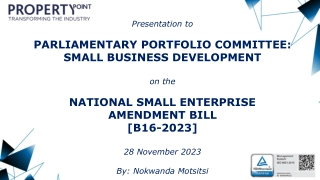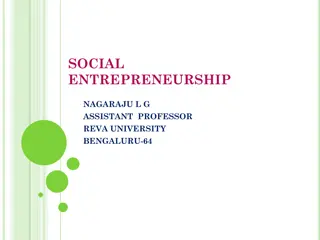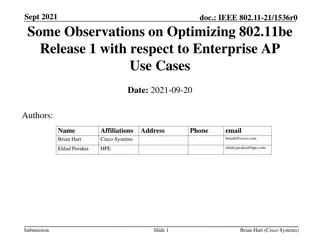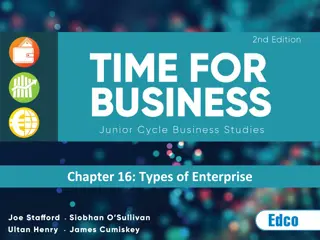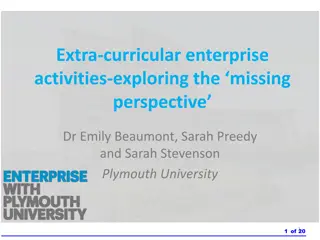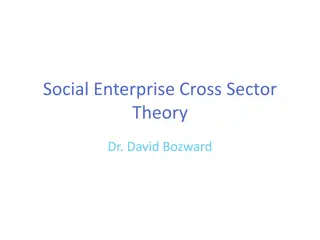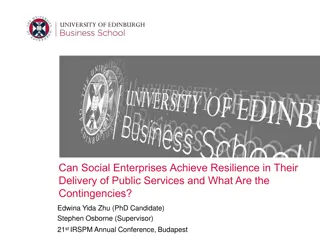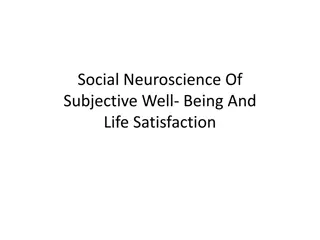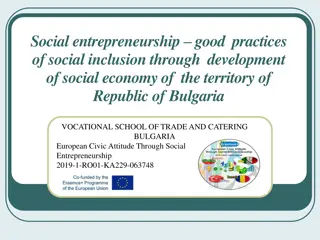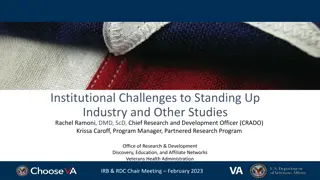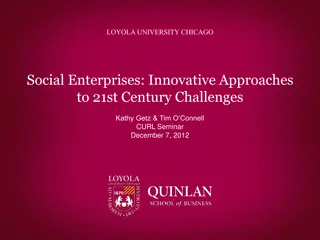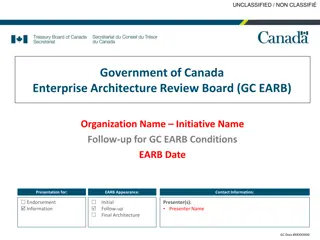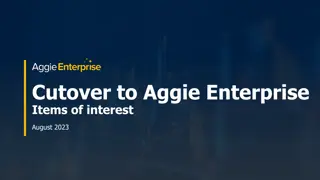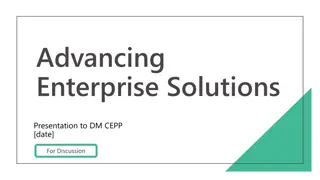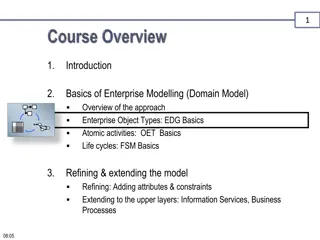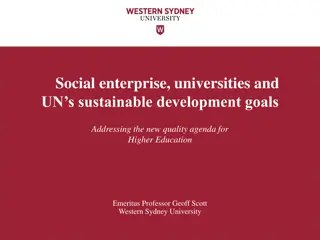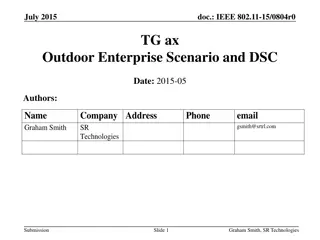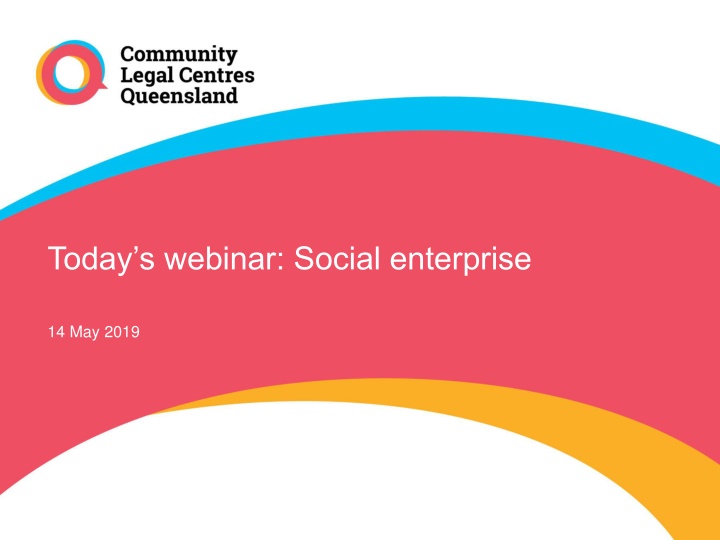
Social Enterprise: Challenges and Solutions
Delve into the world of social enterprise with a focus on challenges faced and effective solutions. This webinar aims to promote awareness and understanding of social enterprise while addressing key issues. Join us to explore the impact and potential of this sector.
Download Presentation

Please find below an Image/Link to download the presentation.
The content on the website is provided AS IS for your information and personal use only. It may not be sold, licensed, or shared on other websites without obtaining consent from the author. If you encounter any issues during the download, it is possible that the publisher has removed the file from their server.
You are allowed to download the files provided on this website for personal or commercial use, subject to the condition that they are used lawfully. All files are the property of their respective owners.
The content on the website is provided AS IS for your information and personal use only. It may not be sold, licensed, or shared on other websites without obtaining consent from the author.
E N D
Presentation Transcript
Todays webinar: Social enterprise 14 May 2019
Acknowledgement of country Community Legal Centres Queensland acknowledges the traditional owners of the land on which we are holding this presentation, the Turrbul and Jaggara people. We pay our respects to their elders, past, present and emerging, and acknowledge the important role Aboriginal and Torres Strait Islanders continue to play in our society. As this presentation is being viewed throughout Queensland, we also pay respect to the traditional owners of the land throughout the country and extend a warm welcome to any First Australians listening to this presentation. Social enterprise for CLCs | 2
GoToWebinar housekeeping Facilitator: Amanda Wisenthal, Project Officer, Community Legal Centres Queensland Recording: This webinar is being recorded and will be available on the Staff Training page of our website: https://communitylegalqld.org.au/clc-staff/staff-training-and-cle PowerPoint / webinar materials: Emailed prior to today s session Available to download from Handouts section of GTW control panel Questions: Type your questions/comments into question box on GTW control panel OR Raise your hand and we will unmute your microphone Questions will be addressed at the end Technical help: Email sdo@communitylegalqld.org.au or use question box in GTW Social enterprise for CLCs | 3
Legal disclaimer This presentation is for professional development and education purposes only. The information provided in this presentation is not legal advice and is designed for lawyers and other staff working and volunteering in a community legal centre setting in Queensland. This presentation and webinar is not to be published or reproduced for commercial purposes without the express permission of the author. Information is current as at 14 May 2019. Community Legal Centres Queensland does not accept any liability for the accuracy of the information in the presentation. Presentation title and date (change on Master page) | 4
Details of presenter Belinda is an Associate Professor in the School of Accountancy at Queensland University of Technology She has approximately 15 years experience in academia, teaching accounting and approximately 10 years working for a Big 4 accounting firm in Australia, Ukraine, Papua New Guinea, and China Belinda s research focuses on accountability and reporting in third sector organisations Social enterprise for CLCs | 5
Aim of this webinar The objectives of this webinar are to: promote awareness and understanding of what social enterprise is highlight some of the challenges faced by social enterprise consider how some of these challenges might effectively be addressed Social enterprise for CLCs | 6
What this webinar covers Background to social enterprise What we know and what we don t know Why social enterprise? Issues regarding social enterprise - legal forms - hybrid nature - reporting Future of social enterprise Social enterprise for CLCs | 7
Background to social enterprise Social enterprise (SE) has emerged as an important part of the third sector - organisations established for a social (or environmental) purpose, which trade to support their mission profit for purpose - balancing money and mission - alternative to traditional not-for-profit model Various organisations in Australia representing SE Social Ventures Australia works with partners to alleviate disadvantage Social Traders connecting social enterprises with social procurement opportunities and supporting social enterprise to successfully deliver on the contracts they win, jointly funded by the Dara Foundation and the Victorian State Government Social enterprise for CLCs | 2
Whats the point of business? Milton Friedman (1970s): maximising profit for shareholders Peter Drucker (1980s): Creating a customer Richard Branson (2000s): making a difference in the world Social enterprise for CLCs | 2
Whats the point of business? The responsibility of business is to make profits while conforming to the basic rules of society, both those embodied by law, and those embodied in ethical custom (Friedman, 1970: 123) Howard Bowen (1953) business managers should follow lines of action which are desirable in terms of the objectives and values of society Bowen (1948) social economy broader concept of economy, whole economic system, comprehensive social fabric Social enterprise for CLCs | 2
Social enterprises position in the business spectrum Non-profit organisation Corporation practising social responsibility For-profit organisation Non-profits with income generating activity (cancer council) Social enterprise Socially responsible business (e.g. charity) (WISE) (Body Shop) (e.g. mining company) Mission motive Profit making motive Shareholder accountability Profit distributed to shareholders Stakeholder accountability Income reinvested in social programs (Based on Alter, 2004) Social enterprise for CLCs | 11
Social enterprises & mission orientation social programs $ social programs enterprise activities $ $ Commercial operations unrelated to mission Mission centric Mission related enterprise activities $ social programs (Based on Alter, 2004, 2007) Social enterprise for CLCs | 12
Development of SE globally Various countries have encouraged the development of social enterprises L3C: low-profit limited liability company in the US legal and tax flexibility social benefits of a non-profit organisation branding and market positioning advantage CIC (Community interest company) in the UK business with primarily social objectives Community contribution company in British Columbia, Canada hybrid organisation Other business forms / certifications Benefit corporations in the US required to consider social, environmental, and financial implications B corporation certification companies assessed and required to score a certain amount for social and environmental performance Social enterprise for CLCs | 13
What we know SE studies Estimated 20,000* social enterprises in Australia Mostly small organisations Gradually maturing sector Various industries and legal forms Legal form Years operating Size (Finding Australia s Social Enterprise Sector (FASES), Barraket et al., 2016) Social enterprise for CLCs | 14
What we know SE studies Beneficiaries Opportunities for social enterprise development: social procurement Needs of social enterprise sector: support in the form of policy finance impact measurement (Based on Barraket et al., 2016) Social enterprise for CLCs | 15
SE: what we dont know Number of social enterprises in Australia Finding Australia s Social Enterprise Sector Barraket et al. (2016) estimated 20,000 social enterprises in Australia No single accepted definition of SE general acceptance of SE as hybrid organisations questions regarding financial sustainability, funding uncertainty financial independence v. financial sustainability / financial security short-term v long-term Social enterprise for CLCs | 16
SE challenges Financial sustainability Mission drift Financing Legal forms / recognition / identity / assistance Measuring or communicating impact Social enterprise for CLCs | 17
Reporting Reporting frameworks GRI SROI OECD, 2015 Integrated Reporting Statement of Recommended Practice (UK) AASB Reporting service performance information ED 270 IPSASB: Recommended practice guideline 3 on reporting service performance information NZASB Service performance reporting Statement of Service Performance (NZ) Productivity Commission Report, 2010 Narratives (e.g. case studies on impact) Social enterprise for CLCs | 18
Reporting in context Reporting frameworks GRI Limitations understandability; disclosure overload no reference to financial performance approximations, proxy amounts, and estimates assumes reliable measurement understandability (i.e. lacks clear and concise detail) SROI OECD, 2015 understandability and comparability lack of a succinct, clear reporting framework no detail on social performance /achievements comparability (lack of a clear reporting framework) Integrated Reporting Statement of Recommended Practice (UK) AASB Reporting service performance information ED 270 comparability (lack of a clear reporting framework) IPSASB: Recommended practice guideline 3 on reporting service performance information NZASB Service performance reporting comparability (lack of a clear reporting framework) outcomes without associated inputs and outputs comparability (lack of a clear reporting framework) incomplete account focus on impacts without inputs, outputs, and outcomes Statement of Service Performance (NZ) Productivity Commission Report, 2010 Narratives (e.g. case studies on impact) Social enterprise for CLCs | 19
Issues re current reporting approaches Image result for stack of papers X disclosure overload X no clear structure X understandability We ve actually worked with [ an accredited assessor of a particular impact measurement method]. The way in which social impact is measured. I couldn t explain it to you The best way of actually explaining what a social enterprise can achieve is through story telling (FASES, Barraket et al. 2016) Social enterprise for CLCs | 20
Challenges re social reporting People are becoming more savvy about what they re investing in, and they re wanting to see that as making a difference as well, and how you actually do that (Manager, NFP, 2014). uncertainty how It s how you tell the story. I have no problem with the narrative but that s not how it s displayed in the annual [financial] accounts. I mean, how do you put a value on a social return.. What s valuable to me and what s valuable to you is very subjective. (Manager, SE, 2014). Interviewer: They re good numbers to advertise [referring to zero defaults on loans]. Manager: I agree, but it s a bit like the Qantas safety record; you just don t want to test fate (Manager, SE, 2014). fear of exposure What s the value of our social contribution? It s a good question. Can you put a hard number on it? Probably not. Do you really need to? Probably not (Manager, PS, 2014). measurement challenges Social enterprise for CLCs | 21
Issues re current reporting approaches Forms of legitimacy Moral Key features Level of evaluation^ Pragmatic Procedural* Structural* Cognitive Output Consequential Social enterprise for CLCs | 22
Considerations re current reporting approaches Forms of legitimacy Moral Key features Level of evaluation^ organisational what an organisation represents the right thing to do Pragmatic participation, responsiveness exchange and influence techniques and processes appropriate routines capacity to perform proper / adequate operations / actions operating how cognitive justification, coherence production; what NGOs produce (Ossewaarde et al., 2008) accomplishments; achievements effectiveness and empowerment (Atack, 1999) making a difference (Lister, 2003) operational Procedural* Structural* Cognitive achievements Output Consequential Social enterprise for CLCs | 23
Principles of financial reporting Relevance Faithful representation to understanding complete account of material aspects Understandability through clear and concise presentation Comparability via structured consistent presentation Reliability verifiable Measurement where reliable Social enterprise for CLCs | 2
Suggested reporting approach Social enterprise for CLCs | 25
Suggested reporting approach Statement of Social performance Inputs Number of paid staff Number of volunteers Mobile vans Number of locations 6 622 9 66 Outputs laundry washed per week conversation 7.1 tonnes 65,000 hours Outcomes helping homeless people living with dignity providing connections for those who feel isolated or excluded providing referrals to other social services where relevant Social enterprise for CLCs | 26
Reflections All businesses have social implications Central position of social enterprise in the business spectrum Need for increased awareness One way of achieving this is (a systematic approach to) social reporting What s the value of social reporting? (potential) (potential) Social enterprise for CLCs | 27
Useful contacts/additional resources Alter, K. (2004, 2007) Social enterprise typology, https://www.globalcube.net/clients/philippson/content/medias/download/SE_typol ogy.pdf Barraket, J. et al (2016), FASES Report, https://www.csi.edu.au/media/uploads/FASES_2016_full_report_final.pdf Centre for Social Impact, UNSW QUT School of Accountancy & Australian Centre for Philanthropy and Nonprofit Studies Social Ventures Australia, www.socialventures.com.au Social Traders, www.socialtraders.com.au Swinburne University of Technology Social enterprise for CLCs | 29
Presentation Title and Footer Information (change on Master page) | 2

